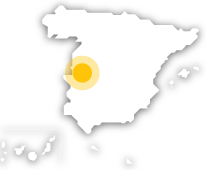
Villuercas Ibores Jara Geopark

It is located in the south of Cáceres (Extremadura), between the basins of the Tajo and Guadiana rivers. Among landscapes of parallel mountains and valleys, its highest point is Risco de La Villuerca (1,601 metres). From its peak, visitors can see magnificent views of the mountains, valleys, Raña characteristics (scrubland) and the city of Guadalupe and its Royal Monastery. It is part of the European Network and the Global Network of Geoparks recognised by UNESCO.
The natural value of this geopark is rare. It is home to more than 40 geological sites that stand out for their paleontological wealth (the archaeological sites contain materials over 560 million years old), their history of mining, or for housing a natural monument such as the Cueva de Castañar de Ibor cave, an underground phenomenon with different shapes and colours. In addition to discovering fossils that lived in the sea which covered this area hundreds of millions of years ago, visitors can also see rock paintings like those at the Cueva Chiquita and Cueva de Álvarez caves, visit old mines like the one at Costanaza (in Logrosán), experience a forest of giant chestnut trees, or be amazed by overlooks such as the one at Peña Amarilla.
Villuercas Ibores Jara Geopark
Desde la A5 (E90) Salida 219 hacia Deleitosa.
10136 Cañamero, Cáceres (Extremadura)
Cáceres (Extremadura):
- Aldeacentenera
- Alía
- Berzocana
- Cabañas del Castillo
- Campillo de Deleitosa
- Cañamero
- Carrascalejo
- Castañar de Ibor
- Deleitosa
- Fresnedoso de Ibor
- Garvín
- Guadalupe
- Logrosán
- Navalvillar de Ibor
- Navezuelas
- Peraleda de San Román
- Robledollano
- Valdelacasa de Tajo
- Villar del Pedroso
Activa JS
What you need to know
-
Cultural information
In this area visitors can find rock paintings, dolmen, forts, castles and Mudejar architecture such as the Royal Monastery of Guadalupe, declared a World Heritage Site by UNESCO. Another monument worth visiting is the Palacio de Miravel.
-
Environmental information
The geological sites are located in unique ecosystems such as Trampal, Lorera and the Mediterranean forest. This geopark also houses seven areas of special protection for birds (ZEPAs).
-
Information for visits
Visitors can find all the information they need for their journey at the diverse Visitor Centres or Information Offices around the area (Guadalupe Tourist Office, Visitor Centre of the “Sierra de las Villuercas and Valle del Guadarranque” ZEPA, Logrosán Museum, Constanza Mine, Hornos de la Calera Visitor Centre, Cueva de Castañar Visitor Centre, Carnaval de Ánimas Visitor Centre in Villar del Pedroso and Regional Archaeological Visitor Centre) Visitors can also complete their visit by trying traditional foods such as “Ibores” goat cheese, “Villuercas-Ibores” honey, “Dehesa de Extremadura” meat and “Ribera de Guadiana” wines. More information about accessing these places.


